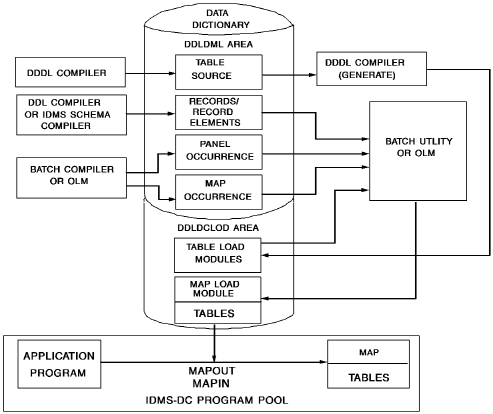

Stand-alone tables can be associated with any record element at map-definition time. Stand-alone tables are typically used to list values when:
A stand-alone table is defined and generated by the TABLE statement of DDDL. Clauses in the TABLE statement determine the search technique, arrangement of values, and the type of values for a table as follows.
Search Technique
The search technique used for the table is determined by the SEARCH IS LINEAR/BINARY clause, as follows:
|
Clause |
Description |
|---|---|
|
SEARCH IS LINEAR |
Specifies that a linear search algorithm is used for the table. The following considerations apply to linear searches:
|
|
SEARCH IS BINARY |
Specifies that the table is searched with a binary search algorithm. The following considerations apply to binary searches:
|
Arrangement of Values in the Table
The arrangement of values in the table is determined by the TABLE IS SORTED/UNSORTED clause, as follows:
|
Clause |
Description |
|---|---|
|
TABLE IS SORTED |
Specifies that values in the table are sorted in ascending order according to the EBCDIC collating sequence. The following considerations apply:
|
|
TABLE IS UNSORTED |
Specifies that values in the table are not sorted; the table is stored in the order of its appearance in the defining TABLE statement. |
Type of Values in the Table
The type of values in the table is specified by the TABLE DATA IS NUMERIC/ALPHANUMERIC clause. This specification affects the results of a table search. For example, the validity of the value 20b (where the b character denotes the blank character) depends on the type of values specified for the table:
Where are Load Modules Stored?
Load modules for stand-alone tables are stored in the DDLDCLOD area of the data dictionary.
Note: For more information about DDDL syntax and syntax rules, see the CA IDMS IDD DDDL Reference Guide.
Linked vs Unlinked
The map developer specifies whether a stand-alone table is linked or unlinked when enabling the table:
It is often preferable to enable stand-alone tables as unlinked tables since stand-alone tables are typically used as general-purpose tables for several record elements.
Compiling, Generating, Loading of maps
Linked Stand-alone Tables
The compilation and runtime loading of a map that uses linked stand-alone tables are illustrated in the following drawing.
A linked stand-alone table becomes part of a map load module that uses it; the map load module must be recompiled if a linked table is changed.

Unlinked Stand-alone Tables
An unlinked stand-alone table is used by a map, but is not part of the map load module; changes to an unlinked table do not affect map load modules that use the table.

|
Copyright © 2013 CA.
All rights reserved.
|
|